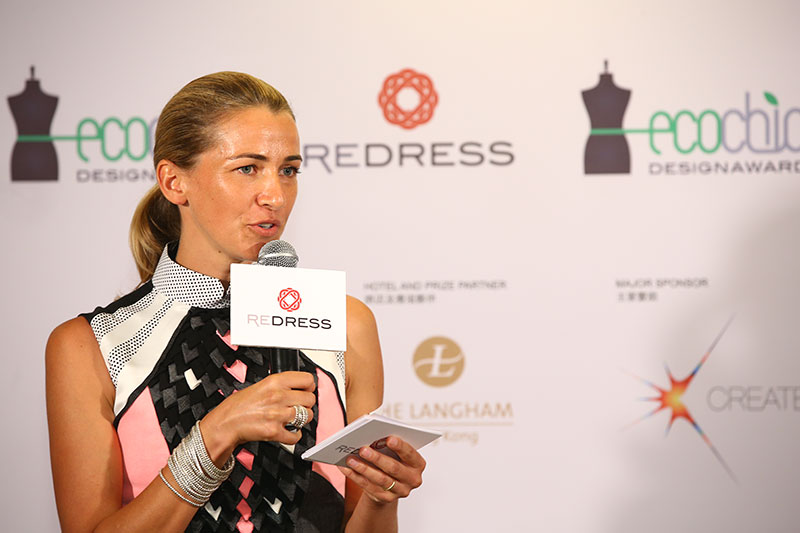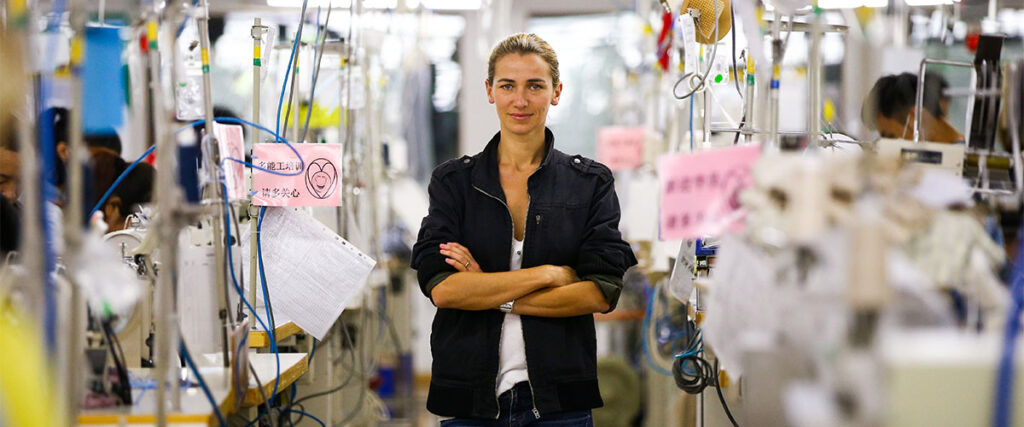Social entrepreneur Christina Dean of Redress and the R Collective opens up about her remarkable journey to change one of the world’s most wasteful industries.
There are people who go out of their way to help others, and then there’s Christina Dean. The South African-born, Hong Kong based humanitarian has been an avid environmental protector for as long as she can remember. “I was quite a prolific Greenpeace supporter from the age of 8, sticking stickers in supermarkets and chasing people down the street, asking them to support Greenpeace,” she recalls. Fast forward three decades and, as the founder of non-profit organisation Redress seeking to change the heart of the fashion industry, her own core still hasn’t changed.

It was on a cycle ride in Southern China that Christina Dean discovered her mission to redress the damage being done by the fashion industry. “It moved my heart seeing the sheer poverty and suffering and the environmental crises being caused by industries, and I knew that fashion was one of the biggest contributors of them all.” A woman of action, Christina Dean soon set up Redress to counter fashion’s part in this process by tackling waste management and creating opportunities for upcoming fashion designers to become more sustainable. Here, she tells us how.

Tell us a little about yourself, Christina.
I was born in South Africa but spent most of my life in the UK where I trained as a dentist. After gaining my diploma at King’s College London, I made the decision to study journalism. It wasn’t long before I realised how better suited I was to journalism, given my nosy nature. In 2004, I moved to Hong Kong, freelance writing about all sorts of topics, especially those related to the environment.
What were you doing before Redress?
When I first moved out, I was providing free dentistry across lesser developed areas in Asia and witnessed firsthand the public health crisis happening there. All industries leave a mark on the environment and the community, but fashion leaves one of the biggest. I saw the problems the fashion industry was causing with my own two eyes and sought to change them however I could.
Can you tell us a bit about how Redress started?
The initial stages were incredibly difficult. Whether a company is non-profit or for profit, there’s a feeling of being left in the dark. We had passion and commitment, but a lot of it was trial and error. I mean, how does one go about even starting to make fashion more sustainable?

We learnt a lot along the way, and are still learning everyday. You really can’t start any business unless you have enough conviction that no one can stop you. This is really important. Everybody has an idea, but you need to believe in it. The failure rate for startups is extremely depressing. So you need to have courage and conviction in what you want to do, and really believe that you can achieve it.
When did you come to notice the sustainability issues surrounding the fashion industry?
I first started noticing the issues when I came into contact with sheer poverty and human suffering. I was distance cycling through southern China, a journey that spanned 1,400km, when I first saw the scale and direct impact of industries such as fashion and manufacturing on the environments around them. That bike ride changed my life.
What was your initial aim with Redress?
Back in the early days, we wanted to promote sustainable fashion, from promoting fair trade, artisanal, organic to recycled.. and the list goes on! But we soon learned that that objective was far too broad. So, after 3-4 years, we zeroed in on one particular aspect – waste reduction and the circular economy. A lot of startups can be way too ambitious, and this is often the downfall of them. Find one thing you are good at, and stick with it.
Redress’ ten year timeline is rather impressive. How have you managed to maintain your vision throughout the years?
I love what we have achieved so far. The problem that you get with startups is that anyone can start. Growing it, however, is a whole different story. My vision for Redress is that it will be here for a hundred years. I have very long term goals and always have done. I’ve found ego to be a huge problem for many entrepreneurs. I’ve come to realise that Redress is its own organism — it’s not my child but instead it belongs to everyone. The best thing to do is to share the organisation with all the people who are passionate about it. You’ll often have to turn the cheek and let other people play a bigger role because that’s what the company needs to grow. Like many things, if you want it to be successful then you can’t be precious about it.
What would you say was Redress’ biggest milestone to date and why?
The biggest milestone for Redress is surviving ten years and still growing! But if I have to choose, I’d say that the Project Redress Design Awards is my proudest milestone because it created such a positive impact on the fashion industry.
What kind of difficulties has the company faced?
We’ve faced so many, but they all tend to relate to funding. Any social entrepreneur can find money, but it’s bloody painful. We worked ridiculously hard to make money and form impact. I must say that the Redress team is completely bulletproof and the reason why is that so many people want to combine their work their values. The team is truly overworked but passion continues to drive them. Staff is not a problem because they are driving a mission that they relate to.
How has the company managed to spread awareness about the sustainability issues in the fashion industry?
Media has helped us a lot. With things like digital print and tv, industry access is no longer too difficult. Getting users interested and contributing, however, is. Media is a massive stakeholder group for us. We have created entertainment driven content such as the documentary ‘Fashion Frontline’, and we hope to reach people in their homes and gain some coveted exposure.
How has the company created a positive change within the fashion industry?
One example would be how we’ve impacted the brand and retail end of things. We’ve achieved a global rollout of recycled textile clothing, and some of our designers have managed to gain retail spots at Lane Crawford, Barneys, and Shanghai Tang.
How can people get involved with your cause?
One way people can get involved is if consumers begin to address their relationship with clothing by actively becoming more aware of what it is they are buying. People can also apply for volunteering opportunities. Companies can also get involved, for example, we recently teamed up with Zara in their takeback program where they donated all their unwanted clothes to us.
Where do you see the direction of the company going in another 10 years time?
We’re hoping to continue with key programs as we don’t want to reinvent any wheels. We’re also aiming for financial sustainability within the organisation by improving strategic management, forecasting, fundraising, and effective business management.
Related Articles
An Insider’s Guide to Thrifting in Hong Kong
The R Collective: Upcycling High Fashion For Greater Sustainability




